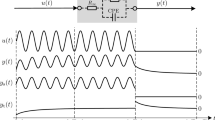Abstract
In the field of bioimpedance measurements, the Cole impedance model is widely used for characterizing biological tissues and biochemical materials. In this work, a nonlinear least squares fitting is applied to extract the double-dispersion Cole impedance parameters from simulated magnitude response datasets without requiring the direct impedance data or phase information. The technique is applied to extract the impedance parameters from MATLAB simulated noisy magnitude datasets showing less than 1.2 % relative error when 60 dB SNR Gaussian white noise is present. This extraction is verified experimentally using apples as the Cole impedances showing less than 3 % relative error between simulated responses (using the extracted impedance parameters) and the experimental results over the entire dataset.







Similar content being viewed by others
References
Aberg P, Nicander I, Hansson J, Geladi P, Holmgren U, Ollmar S (2004) Skin cancer identification using multifrequency electrical impedance—a potential screening tool. IEEE Trans. Biomed. Eng. 51:2097–2102
Atefi SR, Seoane F, Thorlin T, Lindecrantz K (2013) Stroke damage detection using classification trees on electrical bioimpedance cerebral spectroscopy measurements. Sensors 13:10074–10086
Ayllon D, Seoane F, Gil-Pita R (2009) Cole equation and parameter estimation from electrical bioimpedance spectroscopy measurements—a comparative study. In: IEEE International Conference on Engineering in Medicine and Biology Society, Minneapolis, USA, pp 3779–3782
Buendia R, Gil-Pita R, Seoane F (2011) Cole parameter estimation from the modulus of the electrical bioimpedance for assessment of body composition. A full spectroscopy approach. J Electr Bioimpedance 2:72–78
Cole KS (1940) Permeability and impermeability of cell membranes for ions. Proc Cold Spring Harbor Symp Quant Biol 8:110–122
Cole KS, Cole RH (1941) Dispersion and absorption in dielectrics I. Alternating current characteristics. J Chem Phys 9:341–351
Coleman T, Li Y (1996) An interior, trust region approach for nonlinear minimization subject to bounds. SIAM J Optim 6:418–445
Eldarrat AH, Wood DJ, Kale GM, High AS (2007) Age-related changes in ac-impedance spectroscopy studies of normal human dentine. J Mater Sci Mater Med 18:1203–1210
Elwakil AS, Maundy B (2010) Extracting the Cole–Cole impedance model parameters without direct impedance measurement. Electron Lett 46:1367–1368
Elwakil AS, Maundy B (2011) Experimental technique for estimating the dispersion coefficient of a constant phase element. In: European conference circuit theory and design, Linkoping, Sweden, pp 469–471
Ferreira J, Seoane F, Lindecrantz K (2011) AD5933-based electrical bioimpedance spectrometer towards textile-enabled applications. In: IEEE international conference engineering in medicine and biology society, Boston, USA, pp 3282–3285
Freeborn TJ (2013) A survey of fractional-order circuit models for biology and biomedicine. IEEE J Emerg Sel Top Circuits Syst 3:367–376
Freeborn TJ, Maundy B, Elwakil A (2012) Improved Cole–Cole parameter extraction from frequency response using least squares fitting. In: IEEE international symposium circuits systems, Seoul, South Korea, pp 337–340
Freeborn TJ, Maundy B, Elwakil A (2012) Least squares estimation technique of Cole–Cole parameters from step response. Electron Lett 48:752–754
Freeborn TJ, Maundy B, Elwakil A (2013) Cole impedance extractions from the step-response of a current excited fruit sample. Comput Electron Agric 98:100–108
Grimnesand S, Martinsen O (2008) Bioimpedance and bioelectricity basics, 2nd edn. Academic Press, London
Keshtkar A, Salehnia Z, Keshtkar A, Shokouhi B (2012) Bladder cancer detection using electrical impedance technique (tabriz mark 1). Res Int Pathol. doi:10.1155/2012/470101
Krishna B, Reddy K (2008) Active and passive realization of fractance device of order 1/2. Passive Electron Compon Act. doi:10.1155/2008/369421
Kun S, Ristic B, Peura RA, Dunn RM (1999) Real-time extraction of tissue impedance model parameters for electrical impedance spectrometer. Med Biol Eng Comput 37:428–432
Maundy B, Elwakil AS (2012) Extracting single dispersion Cole–Cole impedance model parameters using an integrator setup. Analog Integr Circ Sig Process 71:107–110
McRae DA, Esrick MA, Mueller SC (1999) Changes in the noninvasive, in vivo electrical impedance of three xenografts during the necrotic cell-response sequence. Int J Radiat Oncol Biol Phys 43:849–857
Paterno AS, Stiz RA, Bertemes-Filho P (2009) Frequency-domain reconstruction of signals in electrical bioimpedance spectroscopy. Med Biol Eng Comput 47:1093–1102
Podlubny I, Petras I, Vinagre B, O’Leary P, Dorcak L (2012) Analogue realizations of fractional-order controllers. Nonlinear Dyn 29:281–296
Rigaud B, Hamzaoui L, Frikha MR, Chauveau N, Morucci JP (1995) In vitro tissue characterization and modelling using electrical impedance measurements in the 100 Hz–10 MHz frequency range. Physiol Meas 16:A15–A28
Solmaz H, Ulgen Y, Tumer M (2009) Design of a micro-controller based Cole–Cole impedance meter for testing biological tissues. In: World congress on medical physics and biomedical engineering, Munich, Germany, pp 488–491
Ward LC, Essex T, Cornish BH (2006) Determination of Cole parameters in multiple frequency bioelectrical impedance analysis using only the measurement of impedances. Physiol Meas 27:839–850
Westerlund S, Ekstam L (1994) Capacitor theory. IEEE Trans Dielectr Electr Insul 1:826–839
Acknowledgments
Todd Freeborn would like to acknowledge Canada’s National Sciences and Engineering Research Council (NSERC), Alberta Innovates—Technology Futures, and Alberta Advanced Education & Technology for their financial support of this research through their graduate student scholarships.
Author information
Authors and Affiliations
Corresponding author
Rights and permissions
About this article
Cite this article
Freeborn, T.J., Maundy, B. & Elwakil, A.S. Extracting the parameters of the double-dispersion Cole bioimpedance model from magnitude response measurements. Med Biol Eng Comput 52, 749–758 (2014). https://doi.org/10.1007/s11517-014-1175-5
Received:
Accepted:
Published:
Issue Date:
DOI: https://doi.org/10.1007/s11517-014-1175-5




